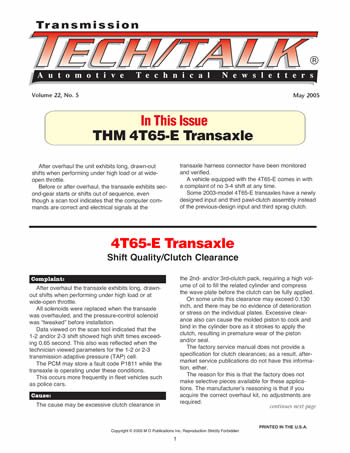Education – Never More Critical Than Now
Yesterday I had the privilege of watching a very well-made training video by Bruce “Doc” Ginther (aka Dr. Dyno), a diagnostician and trainer to the auto-care and transmission industries. It had been quite a while since I had taken in any of that type of training, being mostly involved with sales and management these days. I must say, I was quite impressed with the simple explanations of what I always considered to be the most difficult of diagnostic problems – the electrical system.

May 2005 Issue
Issue Summary:
After overhaul the unit exhibits long, drawn-out shifts when performing under high load or at wide-open throttle.
Before or after overhaul, the transaxle exhibits second-gear starts or shifts out of sequence, even though a scan tool indicates that the computer commands are correct and electrical signals at the transaxle harness connector have been monitored and verified.
A vehicle equipped with the 4T65-E comes in with a complaint of no 3-4 shift at any time.
Some 2003-model 4T65-E transaxles have a newly designed input and third pawl-clutch assembly instead of the previous-design input and third sprag clutch.

Tag, You’re It! A Case of Injustice?
“The Hazardous Waste Manifest System is a set of forms, reports, and procedures designed to seamlessly track hazardous waste from the time it leaves the generator facility where it was produced, until it reaches the off-site waste management facility that will store, treat, or dispose of the hazardous waste. The system allows the waste generator to verify that its waste has been properly delivered, and that no waste has been lost or unaccounted for in the process.”

On-the-Road Diagnosis
The car in Figure 1 is a 2000 BMW 528i that had been to a couple of transmission shops before I got to it. The complaint was that the transmission was in failsafe mode. The car started and moved but would not upshift. The other shops also said they could not communicate with the transmission EGS module.

Advancing Clutch Technology
Last month we discussed pioneering new technology for differentials. Here we look at the cutting edge of manual-transmission clutch technology.

Playing TAPS on Pressure Systems
TAPS is one of the latest acronyms to join the list. It stands for transmission adaptive pressure systems, and it is used both for shift adapts, which establish pressure control during the shift, and for steady-state pressure control, the adapting-pressure requirements for a given gear after the shift is completed.

